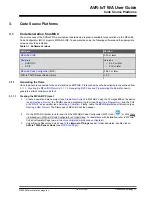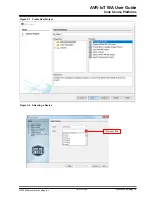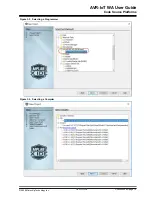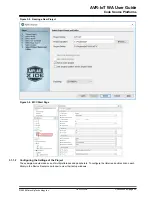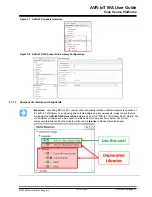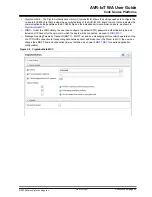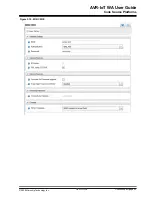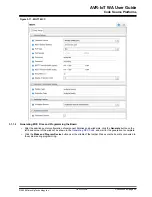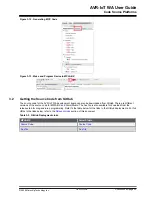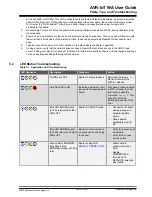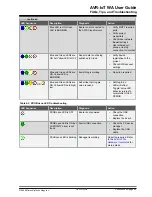
resumes normal behavior of blinking to indicate the transmission sensor data through PUBLISH packets. As with
sending messages, the payload is limited by the MQTT Receive Buffer (bytes) configurable in the MQTT library MCC
window.
Figure 2-11. Viewing Messages on a Serial Terminal
There is no permanent storage or collection of the data published by the boards connected through the Microchip
sandbox account. The full storage features available to AWS Cloud are available to the user after the board has been
removed from the Microchip sandbox and migrated to a private account.
2.5
Configuring Other Settings
While the AVR-IoT WA Development Board comes fully programmed and provisioned right out of the box, the user
can still control aspects of the application firmware behavior through the USB interface. There are three methods to
do this:
1.
Hex file (reprogram) or WIFI.CFG (reconfigure credentials) drag and drop using the mass storage feature.
2.
Commands through the Serial Command Line Interface (CLI), or using MPLAB X IDE.
3.
The on-board programmer/debugger PKOB nano.
2.5.1
Mass Storage Drag and Drop
There are two ways to utilize the Mass Storage Drag-and-Drop Option:
• Program the embedded device is to drag and drop a .
hex
file into the CURIOSITY drive. The C compiler
toolchain generates a .
hex
file for each project it builds. This .
hex
file contains the code of the project. The
Nano Embedded Debugger (PKoB nano) also provides access to a serial port interface (serial to USB bridge).
This facilitates the user to drag and drop a modified .
hex
file, which contains the firmware updates. This feature
does not require any USB driver to be installed and works in all major OS environments.
• If the WiFi credentials need to be reconfigured and/or the board needs to connect to the new access point, the
user can enter the new credentials in the AVR-IoT webpage, download the WIFI.cfg file, and then drag and drop
this file into the CURIOSITY drive. The board securely remembers the last successful connection to the access
point.
2.5.2
Serial USB Interface
The Wi-Fi Access Point credentials can be reconfigured through a Serial Command Line Interface (CLI) on the AVR-
IoT WA Development Boards. This interface may also be used to provide application diagnostic information. To
access this interface, use any preferred serial terminal application (Tera Term, CoolTerm, and PuTTy) and open the
serial port labeled Curiosity Virtual COM port, with the following settings:
Table 2-2. Serial USB Interface Settings
Baud rate Data
Parity bit
Stop bit
Flow control
Local echo
Transmit protocol
9600
8 bits
None
1 bit
None
ON
CR+LF (Carriage
Line Feed)
Note:
For Windows
®
users, the USB serial interface requires the installation of a USB serial port driver, included in
the installation of the MPLAB
®
X IDE.
The user can control the board by typing the command keywords, listed in
AVR-IoT WA User Guide
Getting Started
©
2020 Microchip Technology Inc.
User Guide
DS50002998A-page 14

















